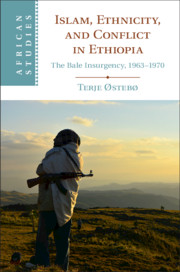Book contents
- Islam, Ethnicity, and Conflict in Ethiopia
- African Studies Series
- Islam, Ethnicity, and Conflict in Ethiopia
- Copyright page
- Dedication
- Contents
- Maps
- Figures
- Tables
- Acknowledgments
- Map
- 1 Introduction
- 2 Islaama Peoplehood and Landscapes of Bale
- 3 Conquest and Resistance
- 4 Bale at War
- 5 The Insurgency: Fighters and Fragmentation
- 6 Peasant Insurgency without Peasants
- 7 Land Tenure and the Land-Clan Connection
- 8 Christianity, Nation, and Amhara Peoplehood
- 9 Trans-local Dynamics: The Bale Insurgency in the Context of the Horn
- 10 Islaama vs Amhara and the Making of Local Antagonism
- 11 The Bale Insurgency, Islaama, and Oromo Ethno-nationalism
- 12 Conclusions
- Glossary
- References
- Index
- African Studies Series
11 - The Bale Insurgency, Islaama, and Oromo Ethno-nationalism
Published online by Cambridge University Press: 28 September 2020
- Islam, Ethnicity, and Conflict in Ethiopia
- African Studies Series
- Islam, Ethnicity, and Conflict in Ethiopia
- Copyright page
- Dedication
- Contents
- Maps
- Figures
- Tables
- Acknowledgments
- Map
- 1 Introduction
- 2 Islaama Peoplehood and Landscapes of Bale
- 3 Conquest and Resistance
- 4 Bale at War
- 5 The Insurgency: Fighters and Fragmentation
- 6 Peasant Insurgency without Peasants
- 7 Land Tenure and the Land-Clan Connection
- 8 Christianity, Nation, and Amhara Peoplehood
- 9 Trans-local Dynamics: The Bale Insurgency in the Context of the Horn
- 10 Islaama vs Amhara and the Making of Local Antagonism
- 11 The Bale Insurgency, Islaama, and Oromo Ethno-nationalism
- 12 Conclusions
- Glossary
- References
- Index
- African Studies Series
Summary
The chapter focuses on how the religious dimension of peoplehood complicated the insurgency movement’s interactions with other Oromo groups and movements. Firstly, it discusses the Shoa Oromo community in Bale – a group that at the outset would ostensibly be close to the Arsi Oromo and share similar antagonist sentiments toward the Amhara and assumingly side with the insurgents against the state. The fact that they did not is noticeable and can only, the chapter argues, be explained by examining the religious dimension. Secondly, the chapter investigates the nascent Oromo ethno-nationalist movement surfacing in the 1960s. As a largely urban elitist movement and dominated by Christian Oromo, it was significantly different from the Bale insurgency. Although the two movements managed to connect, the chapter claims that religion constituted a potential conflictual dimension – something teased out in the chapter’s latter part. Lastly, the chapter explores what role the embryonic Salafi movement – emerging in the 1960s – played in relation to the insurgency. It amply demonstrates that this movement did not contribute to strengthening religious boundaries or reinforcing conflictual lines, in turn pointing to the need to move beyond established assumptions and teleological perspectives when thinking of Islam and politics.
Keywords
- Type
- Chapter
- Information
- Islam, Ethnicity, and Conflict in EthiopiaThe Bale Insurgency, 1963-1970, pp. 288 - 310Publisher: Cambridge University PressPrint publication year: 2020

